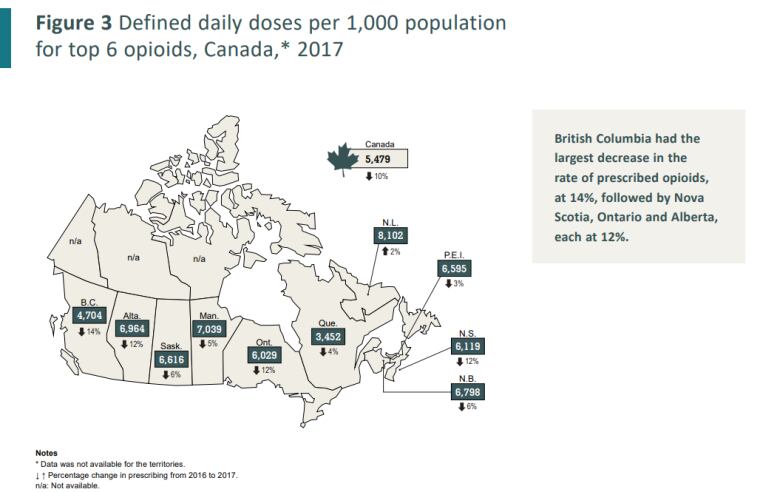Opioid prescription rate up in N.L., down in every other Canadian province
Province also has highest defined daily dose, used to compare different drugs, according to report

Newfoundland and Labrador was the only province in the country to see an increase in the rate of opioid prescriptions last year, according to a new Canadian Institute for Health Informationreport.
This province saw a twoper cent rise while provinces hardest hit by the ongoing opioid crisis like B.C., Ontario, and Alberta saw double-digit percentage drops.
Pan-Canadian Trends in the Prescribing of Opioids and Benzodiazepines, 2012 to 2017 shows the defined daily doses (DDD) for each province in 2017, and the percentage change from the figure from 2016.
Report looks at top six opioids
A DDD is "a way to evenly compare drugs that are prescribed at different dosages at different amounts," manager of CIHI's opioid reporting team, Paul Sajan told CBC News.
"It evens all that out and it allows for even comparison across different drugs."

The CIHI report shows each province's overall DDD for the top six opioids fentanyl, morphine, oxycodone, tramadol, hydromorphone and codine.
Newfoundland and Labrador's opioid DDD is the highest in the country at 8,102 per 1,000 population.
"That would be about eight doses per person within that 1,000 population," Sajan said.
Rates across Canada
By comparison, after a one per cent decreasefrom last year, B.C. had a 2017 DDD of 4,704; Ontario, after a 12 per cent drop, had a DDD of 6,029; and Alberta, which also saw a 12 per cent drop from 2016, had a DDD of 6,964 all per 1000 population.
Quebec had the lowest DDD in the country less than half of Newfoundland and Labrador's at 3,454 after a four per cent decrease from the year before.

No data was available in the territories.
Combining all 10 provinces, Canada saw a 10 per cent decrease overall. The country'sDDD was 5,479.
Opioid prescription rate expected to decline further
"What clinicians and policy makers really hope to achieve through this is more informed discussions between prescribers and patients," Sajan said.
"There probably is no ideal number on defined daily dose but I think the goal is to inform those discussions and to ensure that only those who benefit most from opioids are prescribed the drug."
Sajan attributes the general decline to public health initiatives that have been implemented at varying times across the country.
He anticipates the trend in opioid prescriptions to continue downward in 2018 and 2019 including in Newfoundland and Labrador where, he said, the province has implemented initiatives within the past year.

Physicians and other prescribers in this province now have access to a patient's full medication profile at the time of prescribing something that's not yet available in all provinces, according to Sajan.
He also saidNewfoundland and Labrador's College of Physicians and Surgeons has distributednew prescribing guidelines that help provide clarity and direction by outlining appropriate cases and dosage levels.
"These are all designed to help the the discussions between prescribers and patients," he said.
Illegal market
The CIHI report looks solely at prescriptions. It does not take street sales into consideration.
"The opioid crisis is extremely complex and part of what's missing in this is the impact of the illegal market," Sajan said.
Theopioidcrisis is extremely complex and part of what's missing in this is the impact of the illegal market.- Paul Sajan
"The increase in the illegal market has certainly had a significant impact and may very well continue to grow in Atlantic Canada."
He said it's important to monitor the illegal market as it is"predominantly what's causing harm in Western Canada and increasingly in Ontario."
Benzodiazepines
Newfoundland and Labrador was also the only Canadian province to see an increase in the prescription of benzodiazepines in 2017.
The class of drug isused to treat anxiety and sleep problems but can also cause euphoria and be abused.
This province's rate of prescription increased half a percentage point. It's benzodiazepine DDDwas25,722, per 1000 population.
New Brunswick saw a one per cent decrease from last year, but it's DDDof that drug wasstill the highest in the country at31,555.

Like with opioid prescriptions, B.C. and Alberta had double-digit percentage drops at 14 per cent and 12 per cent, respectively. B.C.'s DDD was 9,656 and Alberta's was 13,291.
Ontario has the lowest benzodiazepine DDD in the country at 9,173. Its prescription rate decreased four per cent from last year.
This is the first time CIHI has included benzodiazepine prescription rates in its opioid report.
"They are not necessarily as harmful as opioids but they also come with risk as well, so we thought it was important to start to highlight some of the trends in some of the benzodiazepine prescribing across the country," Sajan said.
Methodology
The report's data sources and methodology section said data was projected from a sample of more than 6,000 pharmacies, representing more than 60 per cent of all retail pharmacies in Canada.
The initial data was collected by IQVIA which defines itself online as a "human data science company."
"There's very good sampling across the country and they redo it over time and the trends are very consistent over time," Sajan said.
"So there's a great deal of trust in this data and it's widely used by the research community as well."












_(720p).jpg)


 OFFICIAL HD MUSIC VIDEO.jpg)
.jpg)



























































































